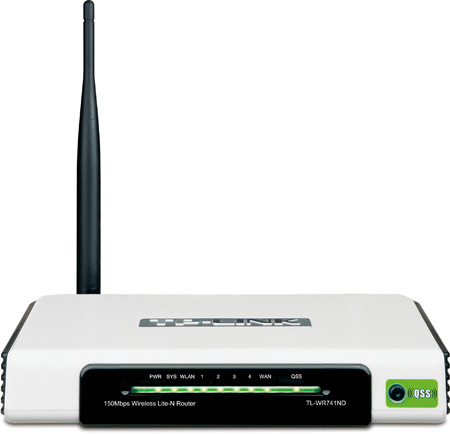Wireless Networking: Nine 802.11n Routers Rounded Up
TP-Link WR741ND
Before prepping this article, we’d never reviewed any TP-Link gear before. The company, based in Shenzhen, China, has obvious aspirations to be the next D-Link by way of being the low-cost leader of the networking world. They approached us months ago with this hot new technology called “Lite-N.” Enough said, right? Still, we make every effort to clear our minds of high-performance prejudices and remember that most of the world just needs cheap gear that gets the job done. This is TP-Link’s target. In thumbing through the catalog that reps sent us along with the WR741ND ($44.99), we couldn’t find a single visually interesting product. It’s all built to be generic. That’s not necessarily bad, but it clearly shows where TP-Link is aiming.
The WR741ND uses a 2x2 MIMO array, but with a single external antenna. You get four 10/100 LAN ports, no USB connectivity. As with Belkin’s N150, this is an ultra-basic, entry-level, 2.4 GHz router. The QSS (Quick Secure Setup) button on the front is rebranded WPS. About the only thing that stands out here is TP-Link’s integration of very simple QoS.
On the other hand, all of that simplicity makes for a very quick setup. Just for giggles, we handed the router to a total networking newbie here at the office and asked her to set it up. She had it running in under 20 minutes. And to TP-Link’s credit, the manual is surprisingly well-produced, with none of the glaring errors and typos we’re used to seeing from lesser-known vendors. The manual even shows screen captures of successful and failed ping tests, which is exactly the sort of thing novices need to see.
We’ll let the cat out of the bag on this one. The WR741ND was the worst-performing router of this roundup, and that was even with using the company’s own TL-WN721N USB adapter. Still, you can find this router online for $35. If all you need is to connect a handful of clients and don’t care so much about the speed at which it happens, yet you at least don’t want to pack a lunch for a 100MB file backup, then this may still be sufficient.
Get Tom's Hardware's best news and in-depth reviews, straight to your inbox.
Current page: TP-Link WR741ND
Prev Page Ruckus Wireless 7811 Next Page TRENDnet TEW-654TR And TEW-671BR-
deividast I want one of those Linksys :) I use now WRT54G and it's doing it's job, but it's a bit slow some times then transfering files from notebook to PC :)Reply -
vant I'm surprised the 610N won. Without testing, the general consensus is that Linksys sucks except for their WRT54s.Reply -
The testing is flawed in that there could be great variability in adapter performance, as admitted by the author. A true "router" comparison would use a common non-partial built-in Intel wifi link miniPCIe card to isolate router performance. Otherwise, too many variables are introduced. Besides, most ppl buy routers for routers, not in matching pairs since most ppl already own wifi laptops or adapters. Smallnetbuilders tested the Netgear WNDR3700 as one of the best performing routers on the market. Obviously this review unit is hampered by the Netgear adapter.Reply
-
vant kevinqThe testing is flawed in that there could be great variability in adapter performance, as admitted by the author. A true "router" comparison would use a common non-partial built-in Intel wifi link miniPCIe card to isolate router performance. Otherwise, too many variables are introduced. Besides, most ppl buy routers for routers, not in matching pairs since most ppl already own wifi laptops or adapters. Smallnetbuilders tested the Netgear WNDR3700 as one of the best performing routers on the market. Obviously this review unit is hampered by the Netgear adapter.Good point.Reply -
cag404 I just replaced my Linksys WRT600N with the Netgear WNDR3700. I have not used the WRT610 that is reviewed here, but I can say that the difference in routers is noticeable. The reason I replaced the router was that the WRT600N was dropping my port settings used to provide remote access to my home server, and I got tired of it. Wanted to try a different router so I went with the Netgear based on a favorable Maximum PC review. Glad I did. It has a snappier feel and I get a stronger signal throughout my two-floor house. The Netgear has not dropped my port settings for my home server yet. Also, I didn't like that fact that Linksys abandoned the WRT600N with no further firmware updates after about the first or second one.Reply -
pato Was the Linksys the V1 or V2 variant?Reply
Which firmware was installed on it?
I have one (V1), but am very unhappy about the signal range! I have it replaced with a WNDR3700 and have now a twice as strong signal as before! -
Would have been nice to see the WAN-LAN throughput/connections as well for wired connections, but I guess all people but me use wireless for everything nowadays...Reply
